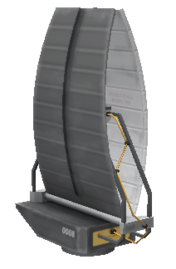M700 Survey Scanner
| M700 Survey Scanner | ||
| Scanner by Experimental Engineering Group | ||
| Radial size | Small, Radial mounted | |
| Cost | (total) | 1 500.00 |
| Mass | (total) | 0.200 t |
| Drag | 0.2 | |
| Max. Temp. | 2000 K | |
| Impact Tolerance | 7 m/s | |
| Research | | |
| Unlock cost | 4 500 | |
| Since version | 1.0 | |
| Part configuration | SurveyScanner.cfg | |
| Mode | Orbital | |
| Resource | All | |
| Scanning time | 5 s | |
| Science bonus | 10 | |
| Min. Altitude | 25 000 m [1] | |
| Max. Altitude | 1 500 000 m [2] | |
| Packed volume | None | |
|
| ||
The M700 Survey Scanner is a part introduced in version 1.0.
Product description
| “ | This orbital survey scanner uses a combination of advanced sensor technology and witchcraft to provide information on a planet or moons natural resources. These images can be viewed either in flight, or in relative safety and comfort back at the KSC. Be sure to bring an antenna capable of transmitting the information back, and sufficient power. | ” |
Usage
The scanner works well on a small 1.25m satellite, but has a heavy electrical demand when activated, so a Z-1k battery is recommended. The electrical demand is heavy, but brief, so it is not necessary to have a huge generating capacity. It is not particularly heavy, so a FL-T200 fuel tank and LV-909 engine are quite adequate for the final stage, providing the necessary power to establish and adjust the orbit, either from LKO to Mun and Minimus, or entry from solar orbit to another system. An antenna is required to upload the data back to KSC, and any antenna will suffice.
Launching should probably make use of a payload fairing or cargo bay, as the scanner is large and not a good aerodynamic shape, and is likely to cause atmospheric control issues when placed on top of a rocket. The scanner requires a stable polar orbit at an appropriate altitude (see below). Once established in orbit, it must first be opened, then the scan can be performed. The scan is a once per body operation, and only takes a few seconds. The data acquired by the scanner is automatically transmitted, and it is the transmission which uses the large quantity of electricity. The scan result can be viewed in the map while controlling the scanner satellite, or from the KSC Tracking Station.
Scanning altitude
The scanner has a minimum and maximum scanning altitude based on the radius of the body it is scanning, clamped to a lowest minimum altitude of 25 km, and highest maximum altitude of 1.5 Mm.
| Celestial body | Radius | Altitude | |
|---|---|---|---|
| Min. | Max. | ||
| Kerbol | 261.6 Mm | N/A | N/A |
| Moho | 250 km | 25 km | 1.25 Mm |
| Eve | 700 km | 70 km | 1.5 Mm |
| Gilly | 13 km | 25 km | 65 km |
| Kerbin | 600 km | 60 km | 1.5 Mm |
| Mun | 200 km | 25 km | 1000 km |
| Minmus | 60 km | 25 km | 300 km |
| Duna | 320 km | 32 km | 1.5 Mm |
| Ike | 130 km | 25 km | 650 km |
| Dres | 138 km | 25 km | 690 km |
| Jool | 6 Mm | 600 km | 1.5 Mm |
| Laythe | 500 km | 50 km | 1.5 Mm |
| Vall | 300 km | 30 km | 1.5 Mm |
| Tylo | 600 km | 60 km | 1.5 Mm |
| Bop | 65 km | 25 km | 325 km |
| Pol | 44 km | 25 km | 220 km |
| Eeloo | 210 km | 25 km | 1.05 Mm |
Changes
- Initial release
